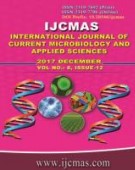


 National Academy of Agricultural Sciences (NAAS)
National Academy of Agricultural Sciences (NAAS)

|
PRINT ISSN : 2319-7692
Online ISSN : 2319-7706 Issues : 12 per year Publisher : Excellent Publishers Email : editorijcmas@gmail.com / submit@ijcmas.com Editor-in-chief: Dr.M.Prakash Index Copernicus ICV 2018: 95.39 NAAS RATING 2020: 5.38 |
Reliable yield forecasting within the growing season would enable better planning and more efficient management of grain production, handling and marketing. Remote sensing provides essential technologies for monitoring and observing rice fields over large areas at repeated time intervals. In this study MODIS- NDVI (MOD13Q1) 16 day composite with a spatial resolution of 250m was used for establishing a relationship with rice yield by empirical method. The analysis was conducted for two seasons viz. Samba rice season of 2015-16 and 2016-17 of Thanjavur district. Multi-temporal MODIS- NDVI images in these two seasons were downloaded and pre-processed including re-projection, file type conversion, extraction etc. The result revealed that best relationship form between NDVI and rice age by fitting a quadratic equation. Out of the 28 locations under study, in 24 locations the R2 values for these equations showed fairly higher values ranging from 0.724 to 0.968. Among the three parameters evaluated in this study, summation of the rice NDVI during observation (∑NDVI) showed the highest exponential relationship with the rice yield. Rice yield prediction for Samba rice during 2016- 2017 was done based on the relationship developed between yield and ΣNDVI, derived during 2015-16, i.e. y = 1903.6e0.0201x (R2 = 0.7495). The predicted Samba rice yield during 2016-17 was compared with the actual yields obtained through crop cutting experiments and out of the ten blocks under study 5 blocks had PBIAS values less than ±10 which indicated the good agreement between actual and predicted yield.
 |
 |
 |
 |
 |